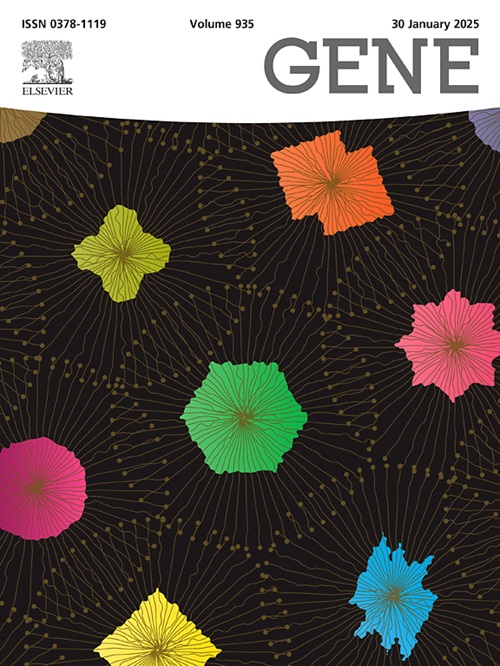对稳定转染沙眼衣原体 CT143 基因后的 HeLa 细胞进行蛋白质组分析。
IF 2.6
3区 生物学
Q2 GENETICS & HEREDITY
引用次数: 0
摘要
背景:沙眼衣原体(Ct)的 CT143 蛋白是一种关键的免疫显性抗原和候选 III 型分泌底物。虽然 CT143 在受感染细胞的细胞质中未被检测到表达,但已知它会干扰 HeLa 细胞的生理行为。本研究旨在探讨 CT143 蛋白如何影响 HeLa 细胞的蛋白表达谱,为进一步研究 CT 的致病机制提供依据:方法:我们构建了稳定转染的 HeLa 细胞系 pCD513B-1-CT143-HeLa 和对照细胞系 pCD513B-1-HeLa。使用液相色谱-串联质谱法(LC-MS/MS)测定了这些细胞系的蛋白质表达谱。对差异表达的蛋白质进行了鉴定,建立了数据库,并使用平行反应监测(PRM)进行了验证。生物信息学软件有助于对这些差异蛋白的生物功能进行初步分析:结果:共有 221 个宿主蛋白质表达存在差异,其中 68 个上调,153 个下调。这些变化影响了肽酶活性的调节,在细胞分泌和蛋白酶活性等生物过程中至关重要。蛋白质加工、醇脱氢酶活性、醛酮还原酶活性和肽酶调节剂活性都发生了显著变化。此外,质膜和细胞外围等细胞成分也发生了变化。涉及造血系统、糖胺聚糖降解、视黄醇代谢和细胞色素 P450 介导的外源性药物代谢的途径受到明显影响。不同表达蛋白之间的间接相互作用包括三个关键的节点蛋白:C3、IFIT3 和 IFIT1:结论:通过用 CT143 基因稳定转染 HeLa 细胞,成功构建了宿主差异蛋白表达谱。鉴定出的差异蛋白参与调控各种生物过程,如细胞内信号转导、细胞分泌、蛋白质加工、水解和酶活性。这些发现表明,CT143 蛋白可能会通过改变宿主蛋白的表达来影响宿主细胞的生物学行为,从而可能阻碍 Ct 的生长和发育。本文章由计算机程序翻译,如有差异,请以英文原文为准。
Proteomic analysis of HeLa cells after stable transfection with the Chlamydia trachomatis CT143 gene
Background
The CT143 protein of Chlamydia trachomatis (Ct) is a key immunodominant antigen and candidate type-III secretion substrate. Although CT143 expression has not been detected in the cytosol of infected cells, it is known to interfere with the physiological behavior of HeLa cells. This study aims to investigate how the CT143 protein affects the protein expression profile of HeLa cells, providing a basis for further research into Ct’s pathogenic mechanisms.
Methods
We constructed a stably transfected HeLa cell line, pCD513B-1-CT143-HeLa, and a control cell line, pCD513B-1-HeLa. Protein expression profiles of these cell lines were determined using liquid chromatography-tandem mass spectrometry (LC-MS/MS). Differentially expressed proteins were identified, constructed into a database, and verified using parallel reaction monitoring (PRM). Bioinformatics software facilitated the preliminary analysis of the biological functions of these differential proteins.
Results
A total of 221 host proteins were differentially expressed, with 68 upregulated and 153 downregulated. These variations influence the regulation of peptidase activity and are crucial in biological processes such as cell secretion and protease activity. Significant changes were noted in protein processing, alcohol dehydrogenase activity, Aldo-Keto reductase activity, and peptidase regulator activity. Furthermore, alterations were observed in cellular components like the plasma membrane and cell periphery. Pathways involving the hematopoietic system, glycosaminoglycan degradation, retinol metabolism, and cytochrome P450-mediated exogenous drug metabolism were notably affected. Indirect interactions among differentially expressed proteins included three key nodal proteins: C3, IFIT3, and IFIT1.
Conclusion
The successful construction of a host differential protein expression profile was achieved through stable transfection of HeLa cells with the CT143 gene. The differential proteins identified are implicated in regulating various biological processes such as intracellular signal transduction, cell secretion, protein processing, hydrolysis, and enzyme activity. These findings suggest that the CT143 protein may influence the host cell’s biological behavior by altering host protein expression, potentially hindering Ct growth and development.
求助全文
通过发布文献求助,成功后即可免费获取论文全文。
去求助
来源期刊

Gene
生物-遗传学
CiteScore
6.10
自引率
2.90%
发文量
718
审稿时长
42 days
期刊介绍:
Gene publishes papers that focus on the regulation, expression, function and evolution of genes in all biological contexts, including all prokaryotic and eukaryotic organisms, as well as viruses.
 求助内容:
求助内容: 应助结果提醒方式:
应助结果提醒方式:


